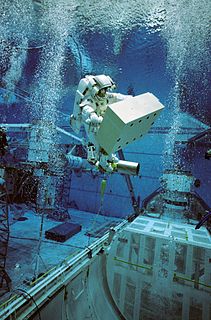
Weight training is a common type of strength training for developing the strength and size of skeletal muscles. It utilizes the force of gravity in the form of weighted bars, dumbbells or weight stacks in order to oppose the force generated by muscle through concentric or eccentric contraction. Weight training uses a variety of specialized equipment to target specific muscle groups and types of movement.

Training is teaching, or developing in oneself or others, any skills and knowledge or fitness that relate to specific useful competencies. Training has specific goals of improving one's capability, capacity, productivity and performance. It forms the core of apprenticeships and provides the backbone of content at institutes of technology. In addition to the basic training required for a trade, occupation or profession, training may continue beyond initial competence to maintain, upgrade and update skills throughout working life. People within some professions and occupations may refer to this sort of training as professional development. Training also refers to the development of physical fitness related to a specific competence, such as sport, martial arts, military applications and some other occupations.

Physical fitness is a state of health and well-being and, more specifically, the ability to perform aspects of sports, occupations and daily activities. Physical fitness is generally achieved through proper nutrition, moderate-vigorous physical exercise, and sufficient rest.

Chinese martial arts, often named under the umbrella terms kung fu, kuoshu or wushu, are several hundred fighting styles that have developed over the centuries in China. These fighting styles are often classified according to common traits, identified as "families" of martial arts. Examples of such traits include Shaolinquan (少林拳) physical exercises involving Five Animals (五形) mimicry or training methods inspired by Old Chinese philosophies, religions and legends. Styles that focus on qi manipulation are called internal, while others that concentrate on improving muscle and cardiovascular fitness are called external. Geographical association, as in northern and southern, is another popular classification method.
Motor learning refers broadly to changes in an organism's movements that reflect changes in the structure and function of the nervous system. Motor learning occurs over varying timescales and degrees of complexity: humans learn to walk or talk over the course of years, but continue to adjust to changes in height, weight, strength etc. over their lifetimes. Motor learning enables animals to gain new skills, and improves the smoothness and accuracy of movements, in some cases by calibrating simple movements like reflexes. Motor learning research often considers variables that contribute to motor program formation, sensitivity of error-detection processes, and strength of movement schemas. Motor learning is "relatively permanent", as the capability to respond appropriately is acquired and retained. Temporary gains in performance during practice or in response to some perturbation are often termed motor adaptation, a transient form of learning. Neuroscience research on motor learning is concerned with which parts of the brain and spinal cord represent movements and motor programs and how the nervous system processes feedback to change the connectivity and synaptic strengths. At the behavioral level, research focuses on the design and effect of the main components driving motor learning, i.e. the structure of practice and the feedback. The timing and organization of practice can influence information retention, e.g. how tasks can be subdivided and practiced, and the precise form of feedback can influence preparation, anticipation, and guidance of movement.
Muscle memory is a form of procedural memory that involves consolidating a specific motor task into memory through repetition, which has been used synonymously with motor learning. When a movement is repeated over time, a long-term muscle memory is created for that task, eventually allowing it to be performed with little to no conscious effort. This process decreases the need for attention and creates maximum efficiency within the motor and memory systems. Muscle memory is found in many everyday activities that become automatic and improve with practice, such as riding bicycles, driving motor vehicles, playing ball sports, typing on keyboards, entering PINs, playing musical instruments, poker, martial arts, and dancing.

The anterior cruciate ligament (ACL) is one of a pair of cruciate ligaments in the human knee. The 2 ligaments are also called cruciform ligaments, as they are arranged in a crossed formation. In the quadruped stifle joint, based on its anatomical position, it is also referred to as the cranial cruciate ligament. The term cruciate translates to cross. This name is fitting because the ACL crosses the posterior cruciate ligament to form an “X”. It is composed of strong fibrous material and assists in controlling excessive motion. This is done by limiting mobility of the joint. The anterior cruciate ligament is one of the four main ligaments of the knee, providing 85% of the restraining force to anterior tibial displacement at 30 degrees and 90 degrees of knee flexion. The ACL is the most injured ligament of the four located in the knee.

Strength training or resistance training involves the performance of physical exercises which are designed to improve strength and endurance. It is often associated with the use of weights. It can also incorporate a variety of training techniques such as calisthenics, isometrics, and plyometrics.

Emergency management is the organization and management of the resources and responsibilities for dealing with all humanitarian aspects of emergencies. The aim is to reduce the harmful effects of all hazards, including disasters.

An isometric exercise is a form of exercise involving the static contraction of a muscle without any visible movement in the angle of the joint. The term "isometric" combines the Greek words isos (equal) and -metria (measuring), meaning that in these exercises the length of the muscle and the angle of the joint do not change, though contraction strength may be varied. This is in contrast to isotonic contractions, in which the contraction strength does not change, though the muscle length and joint angle do.
Periodization is the systematic planning of athletic or physical training. The aim is to reach the best possible performance in the most important competition of the year. It involves progressive cycling of various aspects of a training program during a specific period. Conditioning programs can use periodization to break up the training program into the off-season, preseason, inseason, and the postseason. Periodization divides the year round condition program into phases of training which focus on different goals.
Preparedness refers to a research-based set of actions that are taken as precautionary measures in the face of potential disasters. These actions can include both physical preparations and trainings for emergency action. Preparedness is an important quality in achieving goals and in avoiding and mitigating negative outcomes.
General Physical Preparation, also known as GPP, lays the groundwork for later Specific Physical Preparation, or SPP. In the GPP phase, athletes work on general conditioning to improve strength, speed, endurance, flexibility, structure and skill. GPP is generally performed in the off-season, with a lower level of GPP-maintenance during the season, when SPP is being pursued. GPP helps prevent imbalances and boredom with both specific and non-specific exercises by conditioning the body to work.

The acetabular labrum is a ring of cartilage that surrounds the acetabulum of the hip. The anterior portion is most vulnerable when the labrum tears.

United States Army Basic Combat Training (BCT), also referred to as Initial Entry Training (IET), is the recruit training program of the United States Army, for service in the Regular Army, United States Army Reserve, or the Army National Guard.
Athletics is a term encompassing the human competitive sports and games requiring physical skill, and the systems of training that prepare athletes for competition performance. Athletic sports or contests are competitions which are primarily based on human physical competition, demanding the qualities of stamina, fitness, and skill. Athletic sports form the bulk of popular sporting activities, with other major forms including motorsports, precision sports, extreme sports and animal sports.
A strength and conditioning coach is a physical performance professional who uses exercise prescription to improve the performance of competitive athletes or athletic teams. This is achieved through the combination of strength training, aerobic conditioning, and other methods.
3 point player is a disability sport classification for wheelchair basketball. People in this class have good forward and backward trunk movement but poor to no sideways trunk movement. The class includes people with L2-L4 paraplegia and amputations. Amputees are put into this class generally if they have hip disarticulations or hip abductions. Players in this class can generally rebound balls that are over their heads, but they can have some issues with balance during lateral rebounds.
Football strength is a training regime, considered the most complex physical quality to be developed by an athlete. The training regime, exercises used, how the exercises are performed, and the types of equipment all play important roles in achieving desired results.









